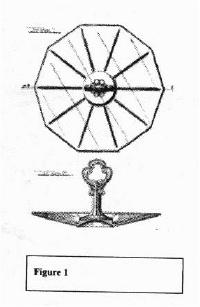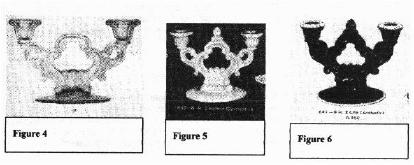National Cambridge Collectors, Inc.
A non-profit 501(c)(3) organization.

Investigating the Keyhole
by Freeman Moore
Issue No. 347 - March 2002
Introduction
This article is the result of a study topic at the North Texas
Cambridge Collectors meeting. We wanted to learn more about the
Cambridge keyhole and share our findings with you. Or is it the
"ring-stem"? We have found references to both terms, but the keyhole
seems to be the more common term.
The March 1992 issue of the Crystal Ball had a trivia question: What is the #11 leg? The answer was provided in the April 1992 issue - it is the keyhole to the 12" vase. This prompted us to suspect that there might be other "legs" - because of the variations in size as well as this being #11. Is there a #10 or #12 leg? We leave this question for someone else to answer since we don't have access to factory records.
Relevant Patents
One part of our research was to find relevant patents. In the past,
we would have browsed the statics of patent books in the government
repository at the Dallas Public Library. This is great for browsing but
very tedious. An improvement is to use the US Patent and Trade Office
website (http://www.uspto.gov). If
the patent number is already known, one can easily get images of the
 patent pages from the web site. This makes looking at known patents
much easier than in the past.
patent pages from the web site. This makes looking at known patents
much easier than in the past.
We found three patents which use the keyhole. However, these patents do not explicitly reference the keyhole as being integral to the item. We have not found a patent for the keyhole itself.
Design #75,380, May 1928 (filed March 24. 1926) is for ... a new. original and ornamental Design for a Tray or Similar Article, of which the following is a specification, reference being had to the accompanying drawing. forming part thereof. Fig. I is a top plan view of a tray showing my new design, and Fig. 2 is a partial section on line 2-2 of Fig 1. I claim: - The ornamental design for a tray of similar article as shown.
W. C. McCartney
(Drawing at right)
Design #78,400, April 1929 (filed Jan 25, 1929), is for ... a new,
original and ornamental Design for Candlestick of which the following is a specification, reference being had to the accompanying drawing, forming part thereof. Fig. 1 is a front elevation of a candlestick showing my new design; Fig. 2 is a top plan view, and Fig. 3 is an end elevation. I claim: - The ornamental design for a candlestick as shown.
J. Clair Kelly
(Drawing at left)
Design #81,989, Sept 1930 (filed Feb 28, 1930). is for ... a new, original and ornamental Design for a Sandwich Tray or Similar Article, of which the following is a specification, reference being had to the accompanying drawing, in which Figure 1 is a side
elevation of a sandwich tray, showing my new design; Figure 2 is a top plan view of the same; and Figure 3 is a section on line 3-3, Fig. 2. The essential feature of the invention resides in the four side portions of the tray each having a single central convex edge and a single pair of similar concave edges, and the four ribs on the bottom of the tray of tapering and substantially prism form that have their outer wide ends terminating at the convex edges of said side portions combined with the circular pedestal for the handle, the pedestal being of relatively small diameter and being surrounded by a ring from which the ribs radiate. I claim: - The ornamental design for a sandwich tray or similar article, substantially as shown and described.
Will Cameron McCartney
(Drawing at right)
Items
The keyhole is commonly found on vases, trays, comports, and
candlesticks.
The candlesticks provided more tidbits of information about the
 keyhole. The original keyhole candlesticks were on the decagon base. In
1937(??), production switched to the round base. In the process, the
keyhole for the 2-lite was modified. It is more rounded in the later
version and includes a knob (aka finial) on the top. (See FIGURES 4 AND
5 for an example of an old style 2-life candlestick contrasted with the
new style 2-lite candlestick. There appears to be a minor difference
between FIGURES 5 AND 6 if you look at the curve under the candle, on
the Crown Tuscan candlestick, it is open, whereas in the Ebony it is
closed.
keyhole. The original keyhole candlesticks were on the decagon base. In
1937(??), production switched to the round base. In the process, the
keyhole for the 2-lite was modified. It is more rounded in the later
version and includes a knob (aka finial) on the top. (See FIGURES 4 AND
5 for an example of an old style 2-life candlestick contrasted with the
new style 2-lite candlestick. There appears to be a minor difference
between FIGURES 5 AND 6 if you look at the curve under the candle, on
the Crown Tuscan candlestick, it is open, whereas in the Ebony it is
closed.
We also found an ashtray on top of the keyhole stem (all Crystal). It is more interesting because we can't find it in published Cambridge catalogs.
Colors
The keyhole is mainly Crystal. There are exceptions, such as Ebony
and Crown Tuscan pieces. We have also seen the 1236 ivy bowl base with
a colored stem.
The 1237, 1238, and 1239 (10", 12" and 14") vases have appeared in a variety of colors and etchings. The response to the April 1982 Crystal Ball trivia question mentioned that on 12/17/51, there were 323 vases made, of which 68 were bad and 235 were good - all in Crystal. The December 1987 Crystal Ball included:
"All of these had a late 1929, 1930 or 1931 introduction and most were featured in crystal and color, plain and etched."
"The 1949 catalog pictured the same three keyhole vases ... were being produced in crystal, amber and amethyst. Two keyhole vases, #1237 and #1236 ... in crystal only, were offered in the final Cambridge catalog."
Availability by Years
We went through the four major Cambridge catalogs to find the first
reference to each item that uses the keyhole. The following table will
help you find an item. We also used the table as a means of dating an
item. For example, the #879 11" handled tray with depressions only
appears in the 1927 catalog. We can only assume it had a short
production time since it doesn't appear in the 1930 catalog. For
example, the #1237, #1238 and #1239 vases enjoyed a long production
item.

Summary
The keyhole is one of those items which is instantly recognizable as
Cambridge. Our study group had a good collection of items to review and
discuss. Sharing our ideas, and questions, is one benefit of a study
group. What else do you know about the keyhole?
References:
(1)1927-1929 Catalog
(2)1930-1934 Catalog
(3)1940 Catalog Reprint
(4) 1949-1953 Catalog
Crystal Ball